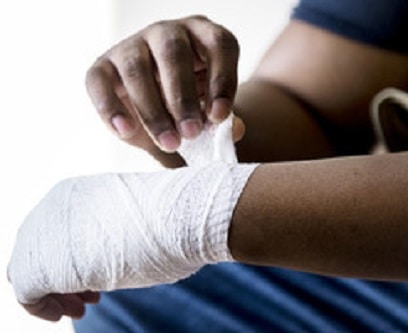10 Simple Tricks For Treating Sporting Injuries

10 Simple Tricks For Treating Sporting Injuries
Exercising and sport is meant to improve your health and fitness and prevent diseases, but often, it can also lead to some aches and injuries. Whether you’re an elite athlete, a professional boxer, or just a recreational jogger, you’ve probably faced an injury or two at some point. One thing which is really important when you get an injury, which most people ignore, is don’t aggravate it with more training.
Its not a question of giving up training, just dont do the things which make the injury sore, or it will never get better. For instance if you are lifting weights and hurt your shoulder, and doing a bench press makes it worse, seriously, don’t do the bench press until the injury has recovered. Or if you are a sprinter and pull your calf muscle running or sprinting, or you get a hamstring tear, more running will make it worse. Its useful to know how to treat a pulled hamstring. See if you can do easy jogs to keep fit as long as it doesn’t hurt your calf. If you can’t, stop. Its common sense which most people ignore.
The same would be true of a knee ligament strain, or even tennis elbow. How would you treat tennis elbow? Use the guidelines below, and try massage, rest and cold packs.
Today, we’ll be looking at the most common sports injuries and how you can treat them initially. Everyone plays football these days, and foot ball injuries are common. You can use the protocols below for some injuries, but for the worst football injuries see a doctor. Indeed, please note, if the injury is more serious, a simple treatment won’t do the trick, and you’ll need to see a doctor after applying the initial treatment in order to fully heal.
Let’s get to it!
Most Common Injuries in Sports
Generally, most sports injuries can be split into two categories: acute and chronic.
- Acute injuries occur as a result of a hit, fall, or any type of trauma to a body part.
- Chronic injuries, on the other hand, are often a result of overuse of the musculoskeletal structure and ongoing stress.
Different sports and different exercise activities can lead to different symptoms and complications. Although many of the injuries feel the same, there are some important differences between them. Let’s look at the most commonly reported injuries in athletes and sportsmen:
- Sprains – overstretching or tearing the ligaments, the tissue connecting one bone to another.
- Strains – similar to sprains, but for muscles and tendons instead of ligaments. Tendons are the tissue that connect the bones to the muscles.
- Tendonitis – an inflammation of a tendon caused by overuse or poor body mechanics. For instance in runners, Patella tendonitis is the most common injury. This is where the tendon which goes from the patella to attach to the tibia gets strained repeatedly.
- Fasciitis – inflammation in the fibrous tissue covering the muscles and tendons, also caused by overuse.
- Dislocation – when bones slip out of their proper joint alignment, resulting in severe pain and weakness.
- Fracture – a disruption in the integrity of a bone, often requiring skilled medical management.
- Muscle cramps – strong muscle contractions that can be very painful.
- Achilles tendon rupture – breaking of the tendon at the back of your ankle, resulting in sudden and severe pain.
- Nose bleeds – these are common in people practising fighting disciplines, such as boxing and MMA.
How to Easily Treat Injuries
Some minor injuries, like sprains and strains, and milder versions of other injuries, can often be initially treated at home for a few days with a few simple things.
- Protection – the first thing to do after an injury occurs is to protect the tissue from further injury. Stop the activity immediately, and apply some bandages or wraps.
- Rest – injured tissues need time to heal. Avoid any kind of exercise and physical activity in the next few days. If you need, use crutches or a walking stick to avoid putting too much weight on your ankle or knee, or a sling to rest your shoulder.
- Ice – it may seem simple, but ice is the cheapest and most effective way to treat many injuries. Cold exposure has anti-inflammatory properties and reduces swelling and pain. Apply an ice pack to the injured area for 15-20 minutes every 2-3 hours. Make sure to wrap the ice pack in a towel, so you can avoid ice burns and further discomfort. ITs a good way to treat pulled hamstrings or acute football injuries. Even those difficult boxing injuries.
- Compression – applying pressure will further help to reduce swelling and inflammation around the injured area. A simple elastic bandage will do the trick.
- Elevation – a simple solution that uses the force of gravity to pull blood away from the injured tissue, resulting in reduced swelling and pain. Keep the injured body part raised above the level of your heart as much as possible.
First Aid for Nose Bleeds
Nose bleeds are pretty common if you got punched hard during a fight, for instance its common boxing injury and frequent MMA injury too. To treat nose bleeds on the spot, follow these guidelines:
- Stop the activity
- Lean your head forward
- Pinch your nostrils together and breathe through your mouth
- Hold your nose for at least 10 minutes
- If the bleeding lasts more than 30 minutes, seek medical help
Besides these simple tricks, further treatment can be recommended after a visit to the doctor’s office, such as:
Pain relief medications
Painkillers, such as paracetamol or ibuprofen, can be used to ease the pain, as well as some pain-relief topical creams to reduce the swelling. You can also find non-pharmacutical creams which help reduce inflammation and ease pain, such as arnica or comfrey cream, both of which are excellent for sprained ankles for instance. You can also purchase arnica pillules (made by brauer) which have excellent anti-inflammatory properties.
Immobilisation
Preventing further damage is best done by reducing movement as much as possible. This can be done with slings, splints, or even casts while you heal.
Osteopathy
If the injury persists and stops you from enjoying your favourite sport or activity, a manual therapy such as osteopathy may help you. Special techniques such as massages, manipulation of the muscles and exercises are used to improve your range of motion and strengthen the muscles around the injured area. This will also help you prevent further injuries. A good osteopath might alsotel you how to treat pulled hamstrings.
Surgery
Most sporting injuries don’t require surgery, but severe cases such as bad fractures, the worst football and MMA injuries, or a torn knee ligament may require a procedure.
Conclusion
If you exercise and push your body to the limit then eventually you will get a sporting injury.It is the nature of the game. Wherever the weakest link in the chain of your muscles is, it will eventually fail. For instance its useful to know how to treat a pulled hamstring. Or you might be exercising the wrong way, or lifting assymetrically. There are a lot of different ways to get a sporting imjury. Trust me, I’ve done most of them.
Getting a sporting injury will likely put you out of the game for a little bit, but it’s nothing to be too afraid of. With the right treatment and first aid help, you will recover quickly and learn a valuable lesson – prevention is better than treatment. Make sure to train all your muscles equally, so they will support you during your most important moments. Anddon’t give up just because you get an injury. Do the right things to fix it and move on, and you will be stonger and faster than before.
Get training!!








[…] 10 Simple Tricks For Treating Sporting Injuries […]
[…] 10 Simple Tricks For Treating Sporting Injuries […]
[…] 10 Simple Tricks For Treating Sporting Injuries […]
[…] 10 Simple Tricks For Treating Sporting Injuries […]
[…] 10 Simple Tricks For Treating Sporting Injuries […]